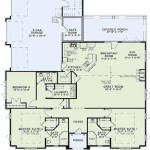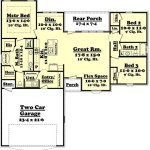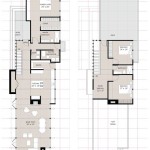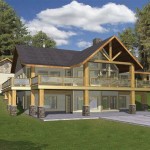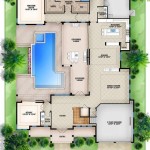Two-Story House Plans With 4 Bedrooms Upstairs: A Comprehensive Overview
Two-story house plans with four bedrooms upstairs represent a popular choice for families seeking ample living space and a distinct separation between living and sleeping areas. This design offers several advantages, including efficient use of land, enhanced privacy, and the potential for architectural diversity. This article will explore the key considerations when selecting or designing a two-story home with this specific layout, encompassing aspects from architectural style and floor plan functionality to cost implications and long-term livability.
Optimizing Space and Functionality
The primary appeal of a two-story, four-bedroom upstairs plan lies in its ability to maximize the use of available land. By stacking the living spaces and bedrooms, the footprint of the house is reduced, making it suitable for smaller lots or locations with specific zoning regulations. This vertical design also contributes to cost-effectiveness, as foundation and roofing expenses are minimized compared to sprawling single-story layouts.
The separation of living and sleeping areas is another significant benefit. This division provides a natural buffer, reducing noise transfer from the common areas to the bedrooms, which is particularly crucial for families with varying schedules or young children. The upstairs area typically becomes a private zone, dedicated to rest and relaxation, while the downstairs area is designated for activities, entertainment, and informal gatherings.
When planning the interior layout, consider the flow of traffic and the proximity of rooms. The staircase location is paramount, as it dictates the accessibility of the upper level. Ideally, the stairs should be centrally located or positioned near the main entrance to facilitate easy access for residents and guests. The placement of the master bedroom and other bedrooms should also be carefully considered based on privacy preferences and noise considerations. For example, bedrooms for young children might be strategically located closer to the master suite for convenience.
Furthermore, the distribution of bathrooms is critical. Typically, a master ensuite is connected to the master bedroom, while a shared bathroom serves the remaining bedrooms. The number of bathrooms and their layout should be determined by the size of the family and their specific needs. Some designs may include a powder room on the ground floor for guest use, preventing them from needing to access the private upstairs area.
The design of the downstairs living spaces should complement the upstairs bedroom layout. A large, open-plan living area can provide a central hub for family activities, while a separate dining room or study can offer more formal or private spaces. The kitchen should be strategically located to provide easy access to the dining area and other living spaces, facilitating meal preparation and serving.
Storage is another crucial consideration. Adequate closet space in each bedroom is essential, as is storage for linens, cleaning supplies, and other household items. Built-in storage solutions, such as shelving units or under-stair storage, can help maximize space utilization and maintain a clutter-free environment.
Architectural Styles and Design Considerations
Two-story house plans with four bedrooms upstairs are adaptable to a wide range of architectural styles, from traditional to contemporary. The choice of architectural style significantly influences the overall aesthetic appeal and cost of the house.
Traditional styles, such as Colonial, Victorian, and Craftsman, often feature symmetrical facades, gabled roofs, and decorative detailing. These styles typically require more intricate construction and higher-quality materials, which can increase the overall cost. However, they offer a timeless elegance and a sense of historical character.
Contemporary styles, such as modern, minimalist, and farmhouse, emphasize clean lines, simple forms, and a focus on functionality. These styles often incorporate large windows, open floor plans, and sustainable materials. Contemporary designs can be more cost-effective to build due to their simplified construction and reduced reliance on decorative elements.
Regardless of the chosen architectural style, several design considerations are essential for a successful two-story home. The exterior design should be aesthetically pleasing and complementary to the surrounding environment. The roof pitch, window placement, and siding materials should be carefully selected to create a cohesive and harmonious appearance.
The interior design should prioritize natural light and ventilation. Large windows and skylights can bring ample sunlight into the living spaces, reducing the need for artificial lighting and creating a more inviting atmosphere. Proper ventilation is crucial for maintaining air quality and preventing moisture buildup, especially in bathrooms and kitchens.
Consider the orientation of the house on the lot to maximize sunlight and minimize energy consumption. Southern exposure can provide natural warmth in the winter, while shading from trees or overhangs can reduce heat gain in the summer. Proper insulation is also essential for maintaining a comfortable indoor temperature and reducing energy bills.
The materials used in construction should be durable, sustainable, and aesthetically pleasing. Consider using recycled materials or locally sourced materials to reduce the environmental impact of the house. Selecting energy-efficient appliances and fixtures can also contribute to long-term cost savings and a more sustainable lifestyle.
Cost Implications and Budgeting
The cost of building a two-story house with four bedrooms upstairs can vary depending on several factors, including the size of the house, the architectural style, the materials used, and the location. It is crucial to establish a realistic budget and carefully track expenses throughout the construction process.
The first step is to obtain accurate cost estimates from qualified builders. It is recommended to obtain multiple bids and compare them carefully. Be sure to include all costs in the budget, including land acquisition, design fees, permits, materials, labor, and landscaping.
One strategy for controlling costs is to simplify the design and construction. Opting for a more basic architectural style, using standard materials, and minimizing intricate details can significantly reduce expenses. Consider making compromises on non-essential features to stay within budget.
Another cost-saving strategy is to prioritize energy efficiency. Investing in energy-efficient windows, insulation, and appliances can reduce long-term operating costs and increase the resale value of the house. Government rebates and tax incentives are often available for energy-efficient upgrades.
Consider the impact of financing on the overall cost. Obtaining a mortgage can significantly increase the total cost of the house due to interest payments. Shop around for the best mortgage rates and terms, and consider making a larger down payment to reduce the amount of interest paid over the life of the loan.
Contingency funds should be included in the budget to cover unexpected expenses or delays. A contingency fund of 5-10% of the total budget is generally recommended. This fund can provide a cushion for unforeseen problems, such as site conditions, material price increases, or unexpected repairs.
Finally, consider the long-term cost of ownership. Property taxes, insurance, maintenance, and repairs should be factored into the overall cost. Choosing durable materials and performing regular maintenance can help prevent costly repairs in the future.
In conclusion, designing or selecting a two-story house plan with four bedrooms upstairs requires careful consideration of space optimization, architectural style, and cost implications. By prioritizing functionality, aesthetics, and affordability, it's possible to create a comfortable and valuable home for many years.

4 Bedroom 2 Story House Floor Plans Elegant Two Home Designs Ideas

Two Story 4 Bedroom Country Home With Upstairs Bonus Room Floor Plan House Plans New

Two Story House Plan With Down Stair Master Plans Layout 6 Bedroom

2 Story Modern House Plan With All Bedrooms Upstairs 85311ms Architectural Designs Plans

4 Bed House Plan With Master On Main And Bonus Upstairs 32655wp Architectural Designs Plans

Two Story 4 Bedroom Home Plan With 3 Car Garage

Rachel Lovely Four Bedroom Two Y Pinoy House Plans

Two Story 4 Bedroom Craftsman House Floor Plan

4 Bed House Plan With Master On Main And Bonus Upstairs 32655wp Architectural Designs Plans

Colonial House Plan With 4 Bedrooms And 2 5 Baths 4338
Related Posts

